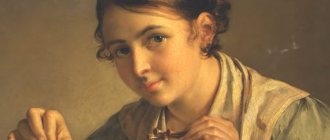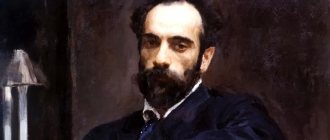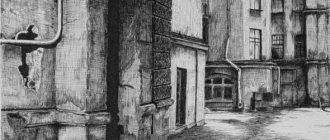Zinaida Serebryakova is an amazing artist who knew how to depict everyday life in bright colors and convey the spark of life through her work. The artist’s wonderful works captivate with their depth, innocence and spontaneity.
This article will be devoted to a description of Serebryakova’s painting “Behind the Toilet.” We will tell you how the artist painted this work.
Zinaida Serebryakova, “Behind the Toilet”: a brief description of the painting
The composition is a self-portrait of the artist: a young woman is reflected in the mirror. The effect of presence is emphasized by the fact that the image shows a mirror frame and a mirrored candle. The artist seems to allow the viewer to look at her through her own eyes.
The girl in the image is combing her beautiful thick hair. She is wearing a light dress, her pose is natural and relaxed, she is looking at herself. The look of the main character of the canvas captivates and makes you fall in love with yourself, it is filled with warmth and love of life, it seems that the girl is about to start singing or laughing sincerely.
In the foreground we see bottles of perfume, a blue pillow with hairpins, a box of beads, ribbons and lace napkins. A simple girlish set speaks of the girl’s playfulness, she is young and wants to emphasize her beauty with pleasant little things.
From the description of Serebryakova’s painting “Behind the Toilet” it is clear that the harmony of warm colors emphasizes the freshness and youth of Zinaida Evgenievna. The love for the everyday little things that surround her is visible in everything. In the background of the painting, the color scheme is more muted and cool. Behind the girl, on the opposite side of the room, there is a washbasin and a jug.
Summing up the description of Serebryakova’s painting “Behind the Toilet,” we can conclude that this work is a reflection of the artist’s inner world, her radiance and genuine feminine beauty.
Tretyakov Gallery part 3. Self-portraits in the works of Zinaida Serebryakova
?g_rybins ( g_rybins
) wrote, 2017-05-10 06:58:00g_rybins
g_rybins
2017-05-10 06:58:00Category: Self-portrait (with bow), 1922. Paper, pastel. Private collection. Courtesy of the gallery OUR ARTISTS, Moscow
The Tretyakov Gallery became the first buyer of the artist's works.
Already in 1910, several of her works were acquired, including her self-portraits and graphics. In those years, she was a happy woman, enjoying her youth and happiness with her husband and motherhood. Life is so interesting that there is no time to even work.
For her public appearance, she chooses the image of a happy young woman, depicted in her self-portrait “Behind the Toilet.” On the dressing table there are many cute little things designed to emphasize her femininity and show the cozy world of women's pleasant activities.
She herself writes that while working on the painting, “she began to draw herself in the mirror and amused herself with depicting all sorts of little things on the toilet.”
Behind the toilet. Self-portrait, 1909. Oil on canvas on cardboard. State Tretyakov Gallery. This portrait was painted far from the brilliant capital of St. Petersburg, in the village of Neskuchnoye on the border of the Kursk and Kharkov regions. Here she felt free, the mistress of the house where her children were born and where she herself was born. Through her radiant smile, through her eyes beaming with happiness, flirtatious and free movements, the feeling of a happy young woman at the toilet is created. All this multitude of emotions cannot be found in a ceremonial portrait; light clothing and an intimate setting create a unique image that won the love of connoisseurs of her work. “A young woman lived in the deep wilderness of the village... and she had no other joy, no other aesthetic pleasure in the winter days that tore her away from the whole world, like seeing your young, cheerful face in the mirror, like seeing your bare hands playing with a comb... Both the face itself and everything in this picture is young and fresh... There is not a trace of any modernist sophistication here. But the simple life situation in the light of youth becomes charming and joyful,” A. N. Benois wrote about this famous self-portrait of Zinaida Serebryakova. Our guide spoke very thoroughly and knowledgeably about each painting presented in the halls. The next portrait is like a dialogue with the masters of the past. Illuminating the face with candle light was Rembrandt’s favorite technique. Zinaida Serebryakova had a brilliant knowledge of art history and studied in private studios. She didn’t get into the Academy of Art because when the time came, she was already married and had her first child. But nevertheless, the best teachers were waiting for her at home. Despite the fact that her father died very early, when Zinaida was only 2 years old, the family was full of exceptional creative personalities. Her father Evgeniy Aleksandrovich Lanceray was a famous animal sculptor, her grandfather Nikolai Benois was a famous architect, her mother Ekaterina Nikolaevna Benois, the sister of the architect Leonty Benois and the artist Alexander Benois, was a graphic artist in her youth. "Girl with a Candle", self-portrait. 1911 Oil on canvas. 72×58 cm. State Russian Museum, St. Petersburg. In the painting “Girl with a Candle,” Zinaida Serebryakova managed not only to create an elegant portrait, but also to anticipate the metaphor of her own life. A young, tender girl with a slight blush on her cheeks turned to look at the viewer from the darkness of the canvas surrounding her. The innocent, trembling face is illuminated by an invisible candle. It seems that this bright and touching heroine is locked in the dark colors of a rectangular frame. But there is no fear or doubt in her large, mirror-shaped almond-shaped eyes. Only determination and an invitation to go with her, following the light of the candle, through the darkness. And just as this young face glows with some kind of inner spiritual warmth, Serebryakova’s soul also glowed. The portrait is left a little unfinished, you can see the movement of the brush, some kind of sketchiness. This style is the artist’s most successful and is repeated in her other best works. Self-portrait as Pierrot. 1911 Self-portrait. 1903. Paper, graphite pencil, tempera. State Russian Museum. Zinaida Serebryakova’s many self-portraits reflect her entire life. She portrays herself in different years in different ways, without embellishing or trying to be different from what she feels at the time of writing. An entire wall is dedicated to self-portraits of this time (1900-early 1910s). They show her different states: here Serebryakova studies her face and the human face in general. They also embody thoughts about personal life during a period when marriage did not go so smoothly. Self-portrait in blue, 1906 Self-portrait, 1903 Self-portrait in a scarf, 1911 In the next portrait, Serebryakova depicts herself expecting her first child. The feeling of a happy woman expecting a child pierces her entire touching and beautiful appearance. Self-portrait. 1906. Oil on canvas. Private collection, Moscow. In those days, it was not customary to emphasize the state of pregnancy and you do not immediately notice its position; at first it seems that it is the loose folds of the dress that lie this way. According to her mother and her uncle Alexander Benois, this was one of the most successful and closest to reality images. She conveys this state of awkwardness, clumsiness and shyness. She not only got along with people, she was timid and at the same time happy in anxious anticipation of the birth of her eldest son, Evgeniy. Self-portrait. 1909. Sketch. Canvas, oil. Private collection, Moscow. This painting, as you might guess, was a sketch for the famous self-portrait “Behind the Toilet.” Photo of Zinaida Serebryakova, taken at the age of over 80 years. Serebryakova’s sister, Ekaterina Evgenievna Zelenkova (nee Lansere, 1882-1921), posed for the sketch and painting “Bather.” Bather. 1911. Oil on canvas. State Russian Museum. Self-portrait 1920s In January 1920, the Serebryakovs moved to St. Petersburg, to the apartment of Nikolai Benois, which, after compaction, became a communal apartment. Zinaida Serebryakova earned money mainly by painting portraits and selling old canvases. She recalled: “I sew all day long... I lengthen Katyusha’s dress, mend her linen... I prepare oil paints myself - I grind the powders with poppy seed oil... We still live by some miracle.” Due to constant poverty, Serebryakova was forced to make her own paints, since there was simply nothing to buy them for. Today, fabulous sums are offered for Serebryakova’s works, although during her lifetime Zinaida was not always able to sell her paintings, and the artist had to live in poverty for almost the entire time allotted on earth. Lonely and irritated, in exile she withdraws more and more into herself. Paris was enveloped in the trends and trends of new fashion in art. The local public, unable to distinguish the beautiful from the bad, liked everything tasteless and mediocre in theater, music, and literature.
“Life now seems to me to be meaningless vanity and lies - everyone’s brains are now very clogged, and now there is nothing sacred in the world, everything has been ruined, debunked, trampled into the dirt.”
note
With her children in mind, she continues to work hard. Soon she manages to discharge Katya to her place, and a little later her son Alexander comes to see her. And then the iron curtain falls. Serebryakova does not dare to return because her two children are in Paris, and she does not risk taking them to the USSR, where they could be declared “enemies of the people.”
In Paris, she cannot fully integrate into her new life, because half of her heart remains there - with Zhenya, Tanya and her mother, whom the government refuses to let go abroad. At the slightest opportunity, Serebryakova sends them money, but this is not always possible. In 1933, her mother dies of hunger in the Soviet Union.
It is possible to meet the children who remained in their homeland only 36 years later - during the Khrushchev Thaw. In 1960, her daughter Tatyana (Tata), who became a theater artist at the Moscow Art Theater, visited her. In 1966, large exhibitions of Serebryakova's works were shown in Moscow, Leningrad and Kyiv.
History of painting
In the description of the painting “Behind the Toilet” by Zinaida Evgenievna Serebryakova, it was already said that the artist herself was painted in this work. The girl painted her self-portrait in 1909, when she was 25 years old.
The canvas was painted during the period when Zinaida lived in the Kursk province, in the village of Neskuchnoye. As the artist herself wrote in her letters, winter came early that year and everything around was covered with snow. The house was cozy and very warm, inspired by the sincere home atmosphere, she began to draw. Today this painting is kept in the Tretyakov Gallery.
An essay based on the painting by Z. E. Serebryakova “Behind the toilet. Self-portrait”
The fate of the talented artist Zinaida Vasilyevna Serebryakova was happy and at the same time tragic. Born into the Lanseray-Benois family, which had several generations of talented architects, sculptors, and artists, Zinaida Vasilievna could not choose another occupation not related to art.
Happy childhood, youth spent in St. Petersburg and the Neskuchny estate near Kharkov, painting, marriage, birth of children, then war, revolution, death of her beloved husband, departure to Paris, separation from children, life and death in Paris.
Recognized in pre-revolutionary Russia, but long forgotten in their homeland, Serebryakova’s works are now world famous.
Painting by Z. E. Serebryakova “Behind the toilet. Self-portrait” from a happy period of her life, it was written
in 1909, on the Neskuchnoye estate, where she and her children stayed until late autumn. One morning, waking up, taking the comb in her hands and going to the mirror, she saw her reflection, which she really liked.
I wanted to capture the happy state I was in. And she was really happy - her adored husband, wonderful children, her favorite job, beautiful nature around her. So the girl drew her self-portrait in the mirror.
The result was not just a portrait, but a genre scene with an abundance of details.
note
What is real on the canvas are the mirror frame and the candlestick, the rest is just a reflection in the mirror through the eyes of the author.
In the center of the picture, its main part is occupied by a very beautiful young woman standing in front of a mirror, combing her long brown hair.
Black eyebrows spread out, brown sly eyes, a hooked nose, pink, beautifully defined lips in a half-smile. A woman recently woke up, wearing a night dress that had slipped off one shoulder. Stately, with beautiful shoulders
and hands with long, strong fingers, half-turned to the mirror, she stands in a room flooded with sunlight.
Like a true woman, going to the mirror in the morning, she decorated herself by wearing a silver bracelet, emphasizing the elegance and grace of her hands. Her hair is so long that she has to hold it with her other hand to comb it.
On the left you can see part of the mirror frame, in which Serebryakova and the candlestick are reflected. In the foreground of the picture are objects standing on a table near the mirror.
A long candle in a copper candlestick, with its reflection in the mirror on the left and right, various feminine accessories on a light tablecloth. There are bottles of perfume, boxes and jars of cosmetics, a painted jar with decorations, napkins, and an embroidered pillow with Chinese hairpins, a pin and a ring.
The hairpins are long, decorated with multi-colored glass balls. In the background of the picture is an interior consisting of simple village household items. A piece of a made bed with a pillow under a lace cover, clothes hanging on a hook, a white double-leaf closed door.
Important
To the woman's left is a simple rustic washbasin with an enamel basin and a faience jug of water. There is a shelf suspended above the basin, on it are soap and a jar of tooth powder, and a towel hangs on a nail next to the shelf. The bottom of the washbasin is equipped according to rustic habits: covered with a curtain, but white, to match the whitewashed walls.
The artist painted an interesting detail - a mirror in a mirror. Above the washbasin, in an oval wooden frame, hangs a small dressing mirror, which apparently reflects the window frame.
The frame of the mirror is not simple, it has wooden candlesticks, because there was no electricity in the village at that time, people washed their faces in the dark with lit candles.
On a sunny winter morning, seeing herself, young, beautiful, full of happiness, Serebryakova wanted to draw what she liked about herself, to perpetuate her image for her loved ones. But to capture it is not for narcissism, because the artist saw in herself an interesting nature, a bright expression of sensuality, and emotional expressiveness of her face.
My husband went on a long business trip and missed the opportunity to see her like this, so I wanted to keep the joy of that winter day as a souvenir.
If the self-portrait had been conceived to present herself in a favorable light, then Serebryakova would not have depicted herself in such a simple setting of village life and in a nightgown. I drew what my soul asked for. The audience of that time liked this emotional impulse, and today’s audience also likes it.
Radiant brown eyes, giving joy and kindness, look at their reflection in the mirror, and seem to penetrate from the portrait into the heart of the viewer, arousing sympathy and admiration.
Advice
If the woman herself is painted in volume, with clear strokes, then the interior, household items, and feminine accessories are depicted in the Art Nouveau style. All of them seem decorative, small and secondary in comparison with the figure of the sitter, only emphasizing her charm, youth and beauty.
The painting was purchased at an exhibition that discovered a new talented Russian artist for the Tretyakov Gallery, where it is exhibited to this day.
Glossary:
– essay on the painting behind the toilet, self-portrait
- essay on the painting of the silver woman behind the toilet
- essay on the painting behind Serebryakov’s toilet
- essay on the painting behind the toilet
– Serebryakov depicted herself on a bright winter morning in front of the mirror
Source: https://ege-essay.ru/sochinenie-po-kartine-ze-serebryakovoj-za-tualetom-avtoportret/
Reviews
Earlier in the description of Serebryakova’s painting “Behind the Toilet,” it was said that the artist portrayed herself as very light and childishly playful. As noted by the famous art critic A. Savinov, this self-portrait lacks any mannerism and artificiality, which was characteristic of painting at the beginning of the twentieth century. This genuine sincerity fascinates and makes you rejoice in life just as this talented girl rejoices.
Art critic D. Sarabyanov said that the most attractive thing about this work is the amazing femininity of the artist. Like Savinov, Sarabyanov emphasizes the simplicity of the surroundings and the overall clarity of the work.









